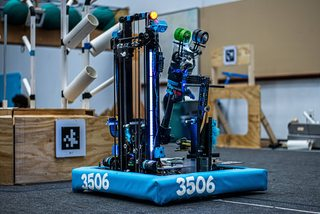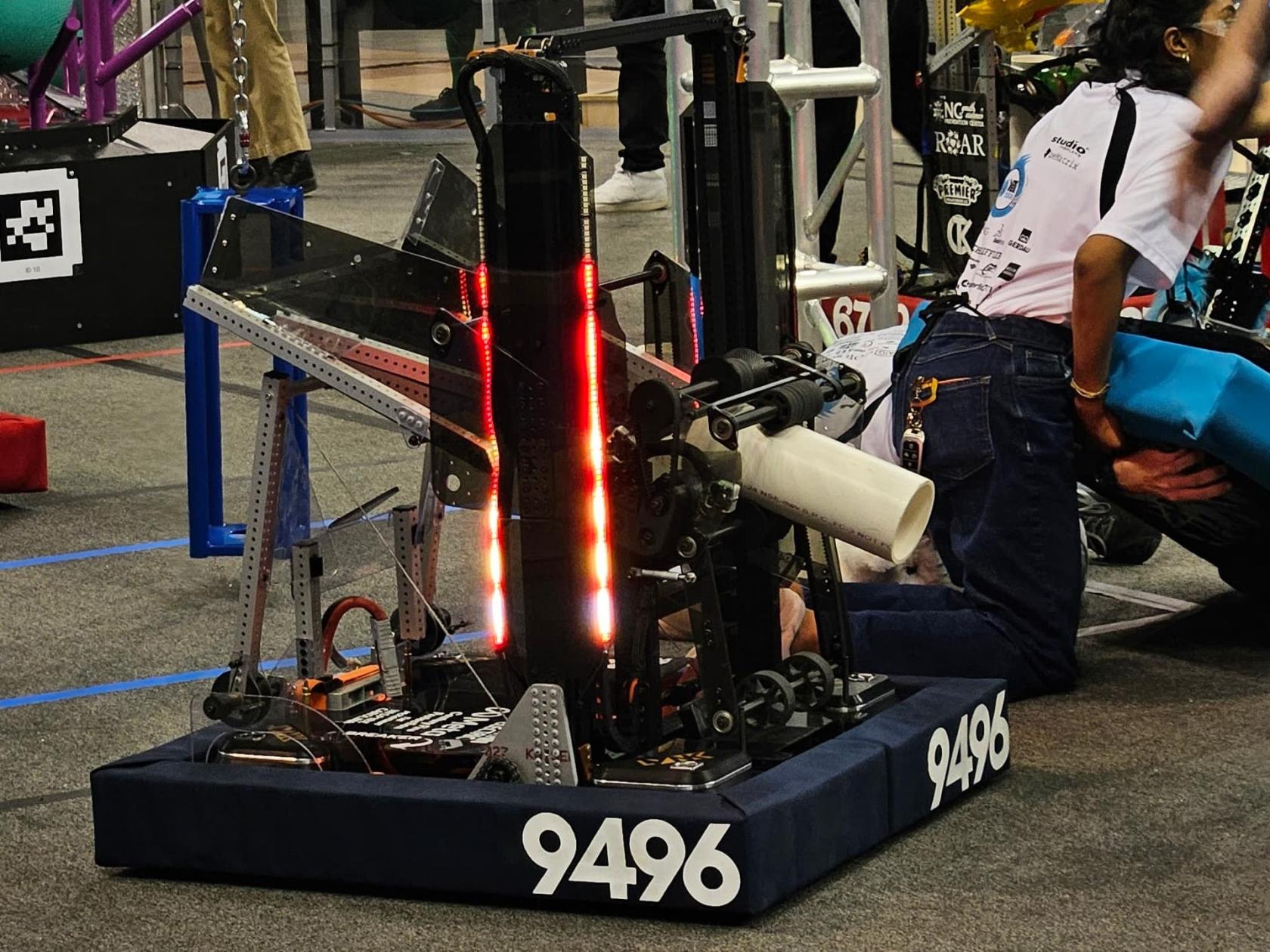Patrick's Rant on why Beluga Sucked (strategically)
(intro tl:dr - having a high skill ceiling means you need to get to that skill ceiling. Simple robots can get going faster and are easier to make)
In 2025, we made the robot Beluga. Though a capable robot, it had one main problem. It had far t̸͚̮̥͙͓͒̋o̷͇͚̔̆o̶̢̝͕̠̘̒͝ ̷̲̑̄m̷̹̯͉͍̽̃̓̚ͅǘ̸͓͖̊̚͝c̷̞̤̪̩͔̍̀ḥ̸̛̤̎͋̽ ̷̠̳̓̃͋͝g̵̭͎̓͐̄̓̚o̸̘̳̐͆̚i̶̗̙̤̳͈̋ṅ̴̟͖͓̪͕̆̎ģ̷̨̝̲͒̍͐̎̈́ ̸͕̲̥̟̅ǫ̷̛̟͈́̓̕n̷͙̫̈̎̀͝. Degrees of Freedom, or DoFs, are a measure of how many different directions a robot can go in. To be competitive, you need to balance how many DoFs you have with how capable a robot is. When having many DoFs (like Beluga), a robot may gain a higher skill ceiling (the absolute max potential of a robot), which will help at extremely high level play, such as division playoffs, given the time. We used the high skill ceiling to justify building such a complex robot, as we believed that the ground intake of 2025’s game piece (a 1 foot long segment of 4.5 inch OD PVC pipe), as teams like 1690, 2056, 27, 4414, and 1678 did. The catch?
All of the teams listed above have World Championship division wins and have a history of winning almost every event attended. Some are even world championship winners. In contrast, our team has won 4 in-season events, only one of which past 2017. They make complicated robots in order to max out at the highest levels of play. We have never reached the same level as these teams, and don't need to.
Beluga
(tl;dr: too much going on)
It is important to take into account how much capacity your team has to push the robot to that skill ceiling. That means a lot of things need to happen, and fast. Getting a robot to its skill ceiling means designing, building, and wiring the robot needs to happen as fast as possible to give time to programming. Beluga was “finished” in approximately Week 6, which gives programming 3 weeks to program a significantly more complicated robot than we have done before. Not including the drivebase, Beluga has 4 DoFs, 3 of which are essential to basic scoring.
-
Vertical 2-Stage Cascade Elevator
-
Rotating ~2 ft long arm
-
Intake Wrist on the end of the arm, theoretically 90 degrees range of motion either way.
-
Climber (doesn’t concern main scoring so not essential)
This meant for a full cycle, all of the following had to happen (minimum)
-
Rotate arm to HP intake
-
Rotate wrist 90 degrees
-
After intaking coral, re-rotate the wrist to 0 degrees
-
Bring arm back to vertical
-
After driving to the reef, extend the elevator up.
-
Rotate arm 45 degrees
-
After alignment, rotate arm further down to score
-
Move elevator down
-
Stow arm
That is a lot to do in terms of programming, and took many iterations to get functional. Optimizing every action here is a lot of work that would require lots of programming time and labor, which we did not have at the time.
An image of Beluga:
Rocky
(tl;dr: simple fast bot wins in NC, this ain’t California)
At our first two events, team 9496 LYNK absolutely dominated the bracket, not dropping a single match and winning as the Alliance 1 Captain. So how did they do it? Are they mentor built? No, their students clearly put in a lot of time. Are they more experienced than us? No, they joined in 2024! Does each of their students have a 254 IQ? Nope. They approached the problem with better strategic design than us. Their skill ceiling, though high, was (arguably) lower than ours. They focused on simplicity in their design, which gave them a high skill floor, meaning how capable something is out of the gate. It also meant that they had less subsystems to design and build. At its first event, Rocky had a grand total of 1 DoF - Their 2-stage Belt in-tube continuous elevator (later added a climber), meaning they had a total of 2 actions to score:
-
Move elevator to correct scoring height
-
After spinning wheels, drop the elevator again.
An image of their robot:
This meant that they needed very little to tune and could get up and running much faster. It is evident how far ahead of us they were at our district events. To quote a member of theirs, "LYNK adds DoFs like amendments to the constitution".
Us versus LYNK at 2025 Mecklenburg District Event: https://youtu.be/MbUwNeuftS8?si=cNCRRYHEQOvEYJDZ
You can clearly see how they were much faster than us because of their low skill floor.
Habits
(tl;dr: this is not new for us we always build complicated robots for NC)
This is a common theme for us when making robots, using many degrees of freedom often makes us less competitive than we could be by designing cleverly. Some examples:
-
2024 - Kitty (an abomination) - Had 3 DoFs not including climber (slapdown intake, pivoting shooter, cascade elevator). Did okay but took too long to build and broke consistently (lots of points of failure like intake belts, bent shooter plates, handoff sequence failing, cracked polycarb intake plates, etc.
-
Winning/Finalist robots in NCCMP:
-
9496 LYNK - no DoFs, only spinning wheels.
-
4795 Eastbots - 1 DoF (pivoting shooter)
-
2642 Pitt Pirates - 2 DoFs (slapdown intake, pivoting shooter)
-
8738 SLICE - 1 DoF (pivoting shooter)
-
2023 - Himalaya (imo our best recent robot) - Had 3 DoFs (pinchy intake, diagonal elevator, flipping end effector on elevator). Handoff from pinchy intake to end effector was nice for doing ground but slowed us down immensely vs other robots (see: 2023 UNC Asheville Playoffs Match 4). Got way faster with just doing HP intake with the end effector and swapped pinchy intake to cube-only slapdown intake which was good for 3 piece auto, got us very far (finalist at Meck + DCMP, first time as first pick at worlds).
-
Winning/Finalist Robots in NCCMP:
-
7890 SeQuEnCe: 3 DoFs (Double-Jointed arm plus end effector pivot)
-
587 Hedgehogs: 2 DoFs (diagonal elevator plus linkage end effector)
-
4795 Eastbots: 3 DoFs (arm + end effector pivot + extra simple slapdown intake)
-
3506 YETI Robotics (yk this one so bonus robot:)
-
Next highest EPA: 5727 Omegabytes - 2 DoFs (double-jointed arm)
Takeaways (read this if nothing else)
-
Less is more: doing something insanely fast out of the gate will be more competitive for district events.
-
Build fast: simple robots are easy to build, meaning that programming gets more time with the robot, driver gets more practice, etc. Also means eventually you will optimize your robot, whereas with Beluga we got nowhere close.
-
Simple is reliable: having less subsystems means you have less failure points, resulting in more reliable scoring (and winning).

